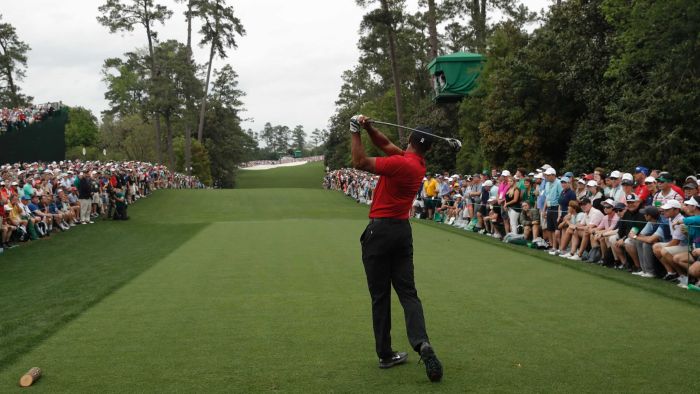For all the purple prose uttered by the heavily vetted TV commentators at the Masters championship, the small screen has never quite done Augusta National golf course justice.
Watching on TV, you can still get a feel for the challenging design. Most famously there is the risk-and-reward of the twin par-five 13th and 15th holes, where the decision to hit the second or — less often now — third shot over Rae’s Creek has made or broken many a final-day charge.
You can drown in the vivid colours. Augusta National’s green fairways are rolled up each winter like carpet and laid again, which ensures they are perfectly manicured and — when it rains — that the smell of manure overpowers that of the clam chowder on the outdoor tables.
But watching on TV, the dimension that is missing is the topography of a course that drops away steeply from the clubhouse down the 10th fairway and is much more undulating than you expect when you have only seen it through the camera lens.
Not only do Augusta National’s troughs make holes more difficult than they might seem on a map, they create small hidden theatres among the dogwood trees from which the roars of the crowd rise and fall like the sound of big waves crashing on an unseen shore.
Actually, don’t ever call those holding a golden ticket to Augusta National part of a “crowd”.
The officially mandated word for Masters spectators is “patrons”, something CBS commentator Jack Whitaker famously forgot in 1966 when he called a large group of fans scurrying toward the green a “mob” and was subsequently banned from calling the tournament for several years by the club’s green-jacketed poobahs.
But whatever you call them, there will be no spectators at Augusta National when the Masters begins on Thursday. COVID-19 has taken much from sport this year, and the latest victim is one of sport’s great soundtracks.
As those who have been to Augusta National will understand, you don’t just watch the Masters by walking the course or by positioning yourself at one of many spectacular vantage points. You sense it all around you.
From inside a sports venue, there are three crowd noises I can still feel when I think of the moment that created them.
There is the roar that followed Cathy Freeman around the track at the Sydney Olympics; the explosion when Usain Bolt virtually jogged across the line in Beijing to win the 100 metres in 9.69 seconds, and the cheer that rumbled through Augusta when Tiger Woods sunk the curling chip shot at the 16th to clinch his 2005 Masters victory.
What made Woods’s chip unique is that it was an entirely aural experience. I was standing under the big tree in front of the clubhouse interviewing players who had completed their rounds when the noise rolled up the hill like a tsunami.
This was just the most remarkable of so many Augusta eruptions. And the reason why a Masters without crowds will seem more unusual than any of the other tournaments played this year with backdrops more like a local club four-ball.
Masters timing may play a factor
Of course, the other significant difference is the postponement from spring, with the azaleas blooming, to autumn — fall, if you like — with the shadows lengthening and perhaps a chill in the air.
Had the Masters been played in its traditional timeslot, the headline would have been the return of Woods to the scene of his incredible drought-breaking 15th major victory in 2019.
Instead there is the kind of trepidation you might expect when Godzilla approaches the city limits as we wonder whether the hulking Bryson DeChambeau will overwhelm Augusta National with his unparalleled combination of gym-built muscle and space-age equipment.




Since winning the US Open in September, DeChambeau has boasted of carrying a drive 400 yards (365 metres) for the first time.
This raises either hopes or fears that the American will turn storied Augusta National into his personal pitch and putt, depending on whether you are part of the Happy Gilmore crowd who marvel at his feats of strength, or a traditionalist lamenting the defencelessness of great courses against souped-up modern clubs and balls.
While DeChambeau’s feats have prompted yet more calls for limits to be imposed on ball technology particularly, nature could provide Augusta’s greatest defence this year.
“The few times I’ve played (Augusta) in November, it’s been the same — it’s been cold and the ball doesn’t go far,” said Woods in a pre-tournament media conference.
“If you are able to get the north wind that time of year, it can be awfully difficult and long and very different than what we normally play in April.”
The initial forecast, however, is for humid and wet weather, meaning greens that are traditionally about as giving as marble floors could be slower — something that might suit Adam Scott, who with Jason Day, Mark Leishman, Cameron Smith and amateur Lukas Michel is one of five Australians in the field.
Scott triumphed on Augusta’s slick surfaces in 2013. But that lone major victory remains a testament to his incredible ball striking, and came despite struggles with the putter that would have tortured those with less sanguine temperaments than the admirable Scott.
Whoever wins, they will do so in the kind of contemplative silence in which golf is played but rarely — at one of its greatest venues — celebrated.







